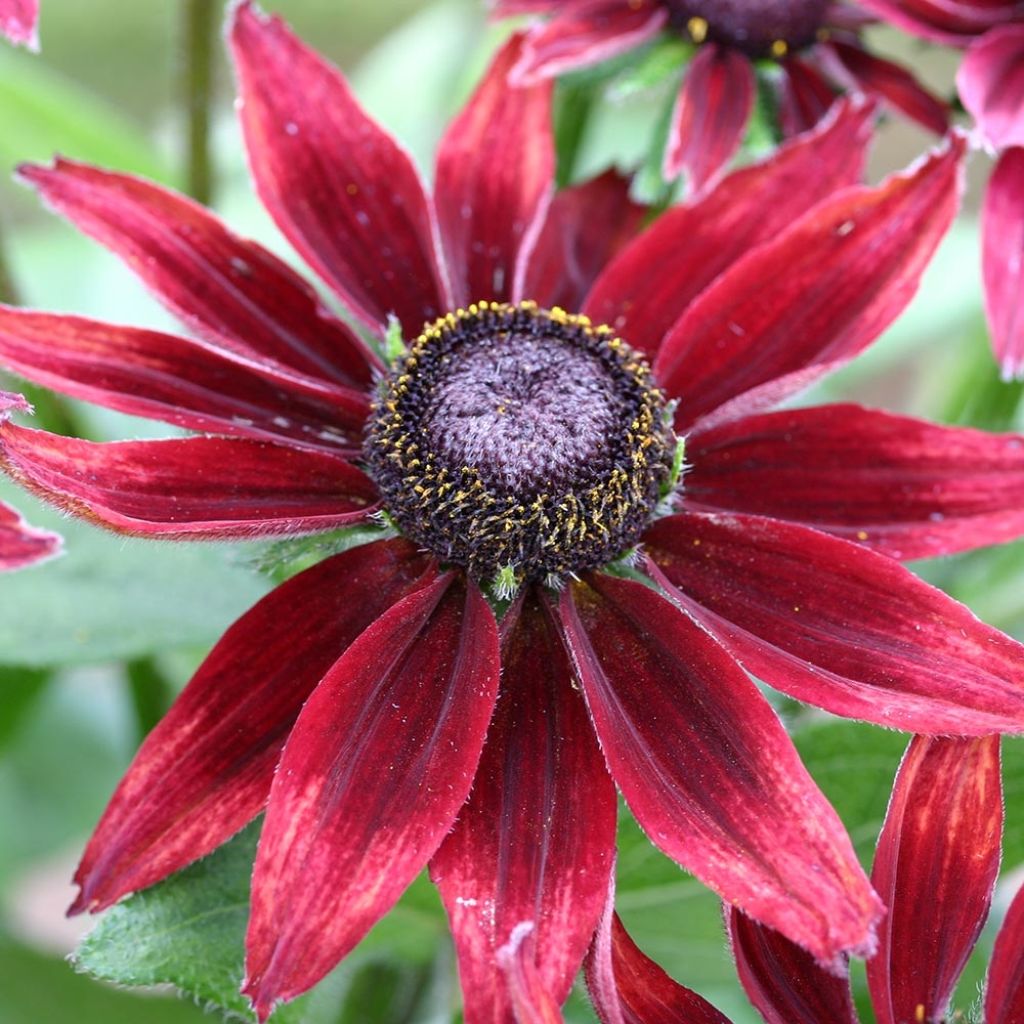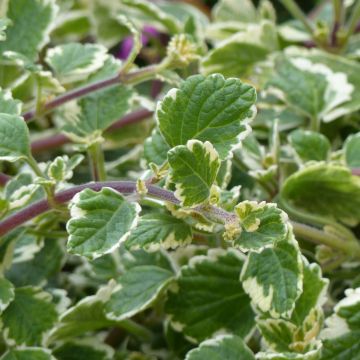

Rudbeckia annuel Cherry Brandy Mini-mottes


Rudbeckia annuel Cherry Brandy Mini-mottes
Rudbeckia hirta Cherry Brandy
Rudbeckia hirta Cherry Brandy
Black-eyed Susan, Gloriosa Daisy, Yellow Ox-eye Daisy
This item cannot be shipped to the selected country
Delivery charge from €5.90
More information
Schedule delivery date,
and select date in basket
This plant carries a 6 months recovery warranty
More information
We guarantee the quality of our plants for a full growing cycle, and will replace at our expense any plant that fails to recover under normal climatic and planting conditions.
From €5.90 for pickup delivery and €6.90 for home delivery
Express home delivery from €8.90.
Does this plant fit my garden?
Set up your Plantfit profile →
Description
The Rudbeckia x hirta 'Cherry Brandy' is a perennial ephemeral plant, offering fully and truly red flowers for the first time, a rich red with a thousand deep and velvety nuances. Its inflorescences, similar to double daisies, display a cherry red colour nuanced with purple and light red towards the tip of the petals, centred on a large black chocolate heart. The flowers renew constantly from July to October on a sturdy plant, magnificent in borders, flower beds, and flower pots. Indifferent to heat and poor soils, it blooms equally well in sunny locations and partial shade.
The Rudbeckia (x) hirta 'Cherry Brandy' is a recent cultivar resulting, among others, from the Hairy Rudbeckia, a wild plant from the asteraceae family native to the North American prairies. It is a perennial ephemeral plant with very rapid growth, most often grown as an annual or biennial. Indeed, in the garden, it will not last more than 2 to 3 years, but it self-seeds quite easily. 'Cherry Brandy' is shorter than its ancestor, reaching a height of 60 cm (24in) and spreading to about 40 cm (16in). This cultivar stands out with the sensational colour of its red flowers with satin and iridescent petals. The inflorescences of the Rudbeckia 'Cherry Brandy' are large daisies or solitary heads with a diameter of 7 to 10 cm (3 to 4in), centred on a prominent black-brown-violet cone. A large number of flowers succeed each other from July to October on the plant, forming an impressive mass. At the end of summer, the petals fade and fall, while the heart of the flowers dries and mummifies. The flowers can then be picked and incorporated into a dried bouquet. The foliage consists of a tuft of lanceolate, dentate basal leaves, dark green, 5 to 10 cm (2 to 4in) long, from which sturdy, ramified floral stems rise. The stems bear narrower, rather oval cauline leaves.
The dumpy silhouette of Rudbeckia 'Cherry Brandy' allows it to fit into perennial flower beds, borders, and large flower pots. It can be paired with other varieties or accompanied by inulas, asters, yarrows, daisies, echinops, phlox. Lighten the scene by mixing in some ornamental grasses such as Stipa tenuifolia, Muhlenbergia capillaris. Splendid in flower beds, its beautiful colours are also very attractive in fresh or dried flower arrangements. It provides a source of fresh flowers for making magnificent summer bouquets. Hardy, the plant likes sunny or semi-shady locations but does not care about the soil; it is a particularly heat-resistant variety and tolerant of dry and poor soils.
An ecological asset: throughout summer, the nectar-rich flowers of Rudbeckias attract pollinating insects and butterflies to your garden. A good way to improve your garden's ecosystem and promote fruit and vegetable production in your vegetable garden. In autumn, you can admire the incessant ballet of birds, especially goldfinches, which will come to feed on the mature seeds they find in the dried flowers' hearts.
Note: Please be aware that our young plug plants are professional products intended for experienced gardeners: upon receipt, transplant and store them under shelter (veranda, greenhouse, cold frame) at a temperature above 14C° for a few weeks before installing them outdoors, once the risk of frost has been definitively eliminated.
Report an error about the product description
Rudbeckia hirta Cherry Brandy in pictures


Flowering
Foliage
Plant habit
Botanical data
Rudbeckia
hirta
Cherry Brandy
Asteraceae
Black-eyed Susan, Gloriosa Daisy, Yellow Ox-eye Daisy
Cultivar or hybrid
Other Annuals A to Z
Planting and care
Hairy Rudbeckias and their varieties are easy-to-grow plants that prefer to settle in spring. They prefer well-drained and fertile soils to support their flowering and require a sunny exposure. To prolong flowering, remove faded flowers as they appear so that the plant does not exhaust itself by producing seeds. In autumn, when flowering is complete, remove leafy stems and divide the stump every three to four years to immediately replant the divisions in another part of the garden. Hairy Rudbeckia is a fairly hardy plant, resistant to temperatures of around -15°C (5°F) in well-drained soil.
Planting period
Intended location
Care
-
, onOrder confirmed
Reply from on Promesse de fleurs
Plug plants - Annuals
Haven't found what you were looking for?
Hardiness is the lowest winter temperature a plant can endure without suffering serious damage or even dying. However, hardiness is affected by location (a sheltered area, such as a patio), protection (winter cover) and soil type (hardiness is improved by well-drained soil).

Photo Sharing Terms & Conditions
In order to encourage gardeners to interact and share their experiences, Promesse de fleurs offers various media enabling content to be uploaded onto its Site - in particular via the ‘Photo sharing’ module.
The User agrees to refrain from:
- Posting any content that is illegal, prejudicial, insulting, racist, inciteful to hatred, revisionist, contrary to public decency, that infringes on privacy or on the privacy rights of third parties, in particular the publicity rights of persons and goods, intellectual property rights, or the right to privacy.
- Submitting content on behalf of a third party;
- Impersonate the identity of a third party and/or publish any personal information about a third party;
In general, the User undertakes to refrain from any unethical behaviour.
All Content (in particular text, comments, files, images, photos, videos, creative works, etc.), which may be subject to property or intellectual property rights, image or other private rights, shall remain the property of the User, subject to the limited rights granted by the terms of the licence granted by Promesse de fleurs as stated below. Users are at liberty to publish or not to publish such Content on the Site, notably via the ‘Photo Sharing’ facility, and accept that this Content shall be made public and freely accessible, notably on the Internet.
Users further acknowledge, undertake to have ,and guarantee that they hold all necessary rights and permissions to publish such material on the Site, in particular with regard to the legislation in force pertaining to any privacy, property, intellectual property, image, or contractual rights, or rights of any other nature. By publishing such Content on the Site, Users acknowledge accepting full liability as publishers of the Content within the meaning of the law, and grant Promesse de fleurs, free of charge, an inclusive, worldwide licence for the said Content for the entire duration of its publication, including all reproduction, representation, up/downloading, displaying, performing, transmission, and storage rights.
Users also grant permission for their name to be linked to the Content and accept that this link may not always be made available.
By engaging in posting material, Users consent to their Content becoming automatically accessible on the Internet, in particular on other sites and/or blogs and/or web pages of the Promesse de fleurs site, including in particular social pages and the Promesse de fleurs catalogue.
Users may secure the removal of entrusted content free of charge by issuing a simple request via our contact form.
The flowering period indicated on our website applies to countries and regions located in USDA zone 8 (France, the United Kingdom, Ireland, the Netherlands, etc.)
It will vary according to where you live:
- In zones 9 to 10 (Italy, Spain, Greece, etc.), flowering will occur about 2 to 4 weeks earlier.
- In zones 6 to 7 (Germany, Poland, Slovenia, and lower mountainous regions), flowering will be delayed by 2 to 3 weeks.
- In zone 5 (Central Europe, Scandinavia), blooming will be delayed by 3 to 5 weeks.
In temperate climates, pruning of spring-flowering shrubs (forsythia, spireas, etc.) should be done just after flowering.
Pruning of summer-flowering shrubs (Indian Lilac, Perovskia, etc.) can be done in winter or spring.
In cold regions as well as with frost-sensitive plants, avoid pruning too early when severe frosts may still occur.
The planting period indicated on our website applies to countries and regions located in USDA zone 8 (France, United Kingdom, Ireland, Netherlands).
It will vary according to where you live:
- In Mediterranean zones (Marseille, Madrid, Milan, etc.), autumn and winter are the best planting periods.
- In continental zones (Strasbourg, Munich, Vienna, etc.), delay planting by 2 to 3 weeks in spring and bring it forward by 2 to 4 weeks in autumn.
- In mountainous regions (the Alps, Pyrenees, Carpathians, etc.), it is best to plant in late spring (May-June) or late summer (August-September).
The harvesting period indicated on our website applies to countries and regions in USDA zone 8 (France, England, Ireland, the Netherlands).
In colder areas (Scandinavia, Poland, Austria...) fruit and vegetable harvests are likely to be delayed by 3-4 weeks.
In warmer areas (Italy, Spain, Greece, etc.), harvesting will probably take place earlier, depending on weather conditions.
The sowing periods indicated on our website apply to countries and regions within USDA Zone 8 (France, UK, Ireland, Netherlands).
In colder areas (Scandinavia, Poland, Austria...), delay any outdoor sowing by 3-4 weeks, or sow under glass.
In warmer climes (Italy, Spain, Greece, etc.), bring outdoor sowing forward by a few weeks.
























































